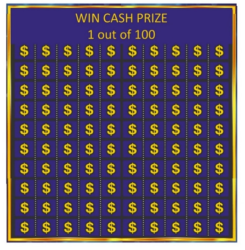Judgment and Decision Making, Vol. 17, No. 5, September 2022, pp. 1015-1042
Loss aversion (simply) does not materialize for smaller losses
Dana Zeif*
Eldad Yechiam#
|
Abstract:
Loss aversion, the argument that losses are given more weight than gains,
has been recently shown to be absent in small losses. However, a series of
studies by Mrkva et al. (2020) appear to demonstrate the existence of loss
aversion even for smaller losses. We re-ran Mrkva et al.’s decision tasks
after removing features of the task that differentiated losses from the
gains, particularly asymmetries in sizes of gains and losses, an
increasing order of losses, and status quo effects. The results show that
we replicate Mrkva et al.’s (2020) findings in their original paradigm
with online participants, yet in five studies where gains and losses were
symmetrically presented in random order (n = 2,001), we find no loss
aversion for small amounts, with loss aversion surfacing very weakly only
for average losses of $40 (mean λ = 1.16). We do find loss
aversion for higher amounts such as $100 (mean λ = 1.54) though
it is not as extreme as previously reported. Furthermore, we find weak
correlation between the endowment effect and loss aversion, with the
former effect existing simultaneously with no loss aversion. Thus, when
items are presented symmetrically, significant loss aversion emerges only
for large losses, suggesting that it cannot be argued that (all) “losses
loom larger than gains.”
Keywords: loss aversion, incentive size, endowment effect, biases
1 Introduction
“Dulce periculum” (danger is sweet)Horace, Odes III, 25, 16
Loss aversion, the notion that losses are given more subjective weight than
gains (Kahneman & Tversky, 1979), is considered one of the most important
contributions of psychology to the emerging science of behavioral
economics (Kahneman, 2011). However, the existence and magnitude of loss
aversion is also one the most debated issues in behavioral economics today
(see e.g., Gal & Rucker, 2018; Yechiam, 2019; Mrkva, Johnson, Gachter &
Herrmann, 2020). The current study aims to revisit a recent set of
findings showing that loss aversion can be demonstrated even in small
monetary amounts (Mrkva et al., 2020). We argue that this and similar
studies may have been using research methods that bias towards loss
aversion and produce conflating evidence.
The polarity of the issue can perhaps best be illustrated by the results of
two (yet unpublished but already influential) meta-analyses. Both used the
extant literature on loss aversion to estimate the value of λ
(loss aversion parameter) which dictates how much a loss outcome is given
more subjective weight than a respective gain outcome.1 The first meta-analysis is by Walasek, Mullett and Stewart
(2018). In their analysis the mean λ across studies was 1.31,
with a lower confidence interval of 1.1 which is rather close to 1
(implying gain-loss neutrality) and a far cry from the initial postulation
by Tversky and Kahneman (1992) that losses have more than twice the weight
of gains (i.e., λ = 2.25). Additionally, only six out of 19
studies in this meta-analysis observed significant loss aversion. These
findings challenge the claim that loss aversion is reliable and robust. On
the other hand, a meta-analysis by Brown, Imai, Vieider and Camerer
(2021) examined a much broader literature and used more lenient inclusion
criteria. Its results indicate a confidence interval between 1.8 and 2.1
for λ. These starkly different findings seem to be due to the
examination of different literatures, different types of tasks used to
elicit loss aversion, and different versions of the models used to
estimate λ (i.e., prospect theory). Importantly, the gap also
emphasizes the fact that there’s no done deal in this story, and suggests
the importance of revisiting prior findings in a meticulous fashion.
A key issue in the debate on loss aversion is whether it is revealed only
for large losses, or also for small losses. The existence of loss aversion
in smaller losses is important both empirically and theoretically.
Theoretically, loss aversion is differentiated from the previous notion of
risk aversion (e.g., Markowitz, 1952; Pratt, 1964; Sharpe, 1964) in
arguing for a simple linear subjective weighting of losses to gains which
is not a function of the size of the outcome (or in other words, that even
small symmetrical risks-benefits are avoided). Moreover, it has been
formally demonstrated by Hansson (1988) and Rabin (2000) that if people
are loss averse for small amounts, this implies that under expected
utility theory with a concave utility function, they should show
puzzlingly high risk-aversion rates.2 Thus, the emergence of loss
aversion for smaller losses results in baffling predictions for a simple
expected utility model.
Yet inconsistently with the notion that loss aversion emerges for smaller
losses, a recent string of studies showed that for small losses
individuals do not reliably show loss aversion, but rather exhibit
loss-gain neutrality (Ert & Erev, 2013; Yechiam & Hochman, 2013; Gal &
Rucker, 2018; Yechiam, 2019) and even gain seeking in some settings (Gal
& Rucker, 2018).
Reacting to these findings, Mrkva et al. (2020) argued that loss aversion
is “alive and well” even for small outcomes. They examined two behavioral
phenomena which they argue are demonstrative of loss aversion. The first
is avoiding risky outcomes involving losses. Specifically, participants
were asked if they agree to accept (i.e., take) or reject a series of
lotteries and investments, with increasing losses. For instance, in their
“lottery task” the first lottery involved a coin toss for either losing 2
Euros or winning 6 Euros, the second lottery had a larger loss of 3 Euros,
etc., up to 7 Euros. The second phenomenon is the endowment effect, the
tendency to valuate sold objects more than purchased ones (Thaler, 1980).
While this phenomenon may be driven by other factors besides loss aversion
(as noted in Gal, 2006; Morewedge & Giblin, 2015; and see also Plott &
Zeiler, 2005), Mrkva et al. (2020) suggested that a correlation between
the size of the endowment effect and the estimated loss aversion for risky
lotteries implies that both are related to the same construct.
Mrkva et al.’s (2020) results using a very large sample showed a mean
λ parameter higher than 1 (indicatory of loss aversion) in all
of their studies of risky lotteries and investments, even for small losses
of 2 to 7 Euros. Moreover, in most of their studies the mean λ
topped the 2.25 observed in the seminal study by Tversky and Kahneman
(1992). There was also a strong correlation between λ in
hypothetical investments and the extent of the endowment effect calculated
for the same participants.
However, there are important details that must be considered when
evaluating these results, and those of previous studies that used the same
approach for extracting the loss aversion parameter (e.g., Tversky &
Kahneman, 1992; Shang et al., 2021), which could be referred to as the
“list method” (Holt & Laury, 2002) and is indeed one of the most popular
ways of quantifying loss aversion in the literature (see e.g., Brown et
al., 2021).
The first and perhaps most important feature of the list method is that
gains and losses are asymmetric, and therefore random noise and
ranking-based choices may bias participants towards loss aversion (as also
noted by Mrkva et al., 2020; and see related results in Ert & Erev, 2013;
Walasek & Stewart, 2019; Rakow, Cheung & Restelli, 2020). For example,
in Study 1B, Mrkva et al. (2020) examined the response to investments with
a 50:50 chance of winning $100 and losing either $10, $25, $50, or
$100 (in different investments). Notice the asymmetry of gains and
losses. Under prospect theory (specified with a linear value/utility
function, as detailed in Study 1), responding “reject” to all four items
implies a lower boundary of 10 for λ, while rejecting three to
zero items (in order) implies a lower boundary of 4, 2, 1.33, and 0,
respectively. Therefore, if a person answers randomly s/he would have a
mean orthodox λ of 3.47, and random error biases responses in
the direction of loss aversion (see also Budescu, Wallsten & Au, 1997).
In addition, if a person is highly sensitive to the ranking of gains and
losses, they would similarly opt for the option with the middle-sized loss
producing an inflated λ score (Walasek & Stewart, 2019).
Secondly, because losses presented in the list method steadily increase
some participants may treat multiple items inter-relatedly and accept the
lottery with the lowest loss, as if it was the “most correct” answer in a
multiple-choice exam. Thus, the monotonically increasing size of losses may
further bias participants towards loss aversion. Thirdly, the list method
typically conflates loss aversion with the status quo effect because
rejecting the lottery (and avoiding losses) is the status quo (Ert & Erev,
2013; Yechiam & Hochman, 2013).3 Notice that these
effects not only potentially increase loss aversion but can also create a
false correlation between the endowment effect and loss aversion. This
correlation could result from the similarity of the phrasing and the fact
that participants who treat the task as a multiple-choice test would aim to
get the best “bargain” in both.4
Here, we aimed to examine whether these features of the list method provide
sufficient conditions for the gap between Mrkva et al.’s (2020) results
and the absence of loss aversion recorded in other studies (e.g., Ert &
Erev, 2013; Gal & Rucker, 2018). Our study can be thought of as extending
the critique of Ert and Erev (2013) on the list method with the additional
novel prediction that the monotonic order of outcomes sizes inflates loss
aversion, in addition to the non-symmetry of gains and losses and the
status quo effect (examined by Ert and Erev, 2013). Indeed, Ert and Erev
(2013) were not able to significantly replicate loss aversion in their
study of the “original” list method, and this may be because they used a
random rather than increasing-losses order. By examining all three
features of the list method – asymmetry of items, order, and status quo –
we wish to shed light and explicate the gap between the arguments made in
favor and against loss aversion, and specifically the argument that loss
aversion emerges both for smaller and larger losses, versus the
counter-claim that it only emerges for larger losses.
Following Kahneman and Tversky’s (1979) original postulation that loss
aversion implies that “most people find symmetric bets of the form (x,
.50; -x, .50) distinctly unattractive” (p. 279), and the modeling critique
of Walasek et al. (2018), our primary dependent variable is a behavioral
measure of loss aversion given symmetric gains and losses. In addition, we
also approximated λ, using the exact same modeling approach as
in Mrkva et al. (2020). In the first five studies we focused on the
emergence of loss aversion in decisions under risk and experimentally
tested the possible effect of items order (increasing versus random
losses), the status quo bias, the size of the outcomes, and task
instructions (lottery versus investment task). In the last study we
examined the possible correlation between loss aversion and the endowment
effect.
2 Study 1: Replication and the effect of random order
Our studies were administered online with Prolific Academic participants.
Therefore, given the different population from that of Mrkva et al. (2020)
it was important for us to try and replicate their results using their
original lottery and investment tasks. In addition, in this study we
examined the effect of the increasing losses used in Mrkva et al. (2020).
As noted above, we argue that these monotonic increases can lead to a
mindset that different items are inter-related. This can escalate loss
aversion because some participants may treat items interconnectedly and
select the “best answer” of partaking the lottery (or investment) with the
smallest loss. We therefore compared an increasing-loss order to a
condition where items are randomly ordered.
2.1 Method
2.1.1 Participants
All studies were conducted with Prolific Academic workers from the USA, UK,
Ireland, Australia, and Canada who had an approval rate of at least 95%
and who stated that English was their first language. Higher approval
rates on Prolific are associated with less dishonest behavior (Schild,
Lilleholt & Zettler, 2019). A total of 400 participants (199 females,
197 males, 4 other) volunteered to take part in the study.5
Their average age was 37.4 (SD = 12.7) with individuals ranging from 18 to
78 years old. From this sample, 201 participants were randomly allocated
to the increasing-loss condition and 199 participants were allocated to
the random-loss condition. Participants provided informed consent
statements, and all studies were ethically approved by the authors’
university ethics committee. Participants in both conditions received a
fee of $1 for completing the study.
2.1.2 Task
We administered Mrkva et al.’s (2020) lottery task (from their Study 1)
followed by the investment task (from their studies 2B-2D). The
increasing-loss condition conformed to the exact order of items as in
Mrkva et al, with the first items having the smallest losses, and with the
loss monotonically increasing from item to item (see supplementary section
for the exact items and their order). In the random-loss version we used
the exact same items, but their order was separately randomized for each
participant. Subsequent studies also controlled for task order (lottery
vs. investment). Complete task instructions are presented in Appendix A.
Each item (lottery/investment) was presented on a separate screen with a
“next” button to move to the next item. In total, the two tasks included
10 items. Following these two tasks, participants completed a short
demographic questionnaire in which they reported their age, gender,
education, and definition of wealth and household income (following Mrkva
et al., 2020; see supplementary section).
2.1.3 Analysis
We used two indicators of loss aversion: First, we examined risk taking for
the lottery with symmetric gains and losses (following Kahneman & Tversky,
1979). Secondly, the loss aversion coefficient λ was cautiously
estimated for each individual participant by dividing the constant gain
(e.g., 6 in the lottery task, 100 in the investment task) by the smallest
loss for which the gamble was not accepted (see also Hermann, 2017), as in
Mrkva et al. (2020). Mrkva et al.’s (2020) basic version of prospect
theory assumed a linear weighting function, namely no diminishing
sensitivity (indeed for the amount sizes used here, no strong diminishing
sensitivity is expected; Abdellaoui, Bleichrodt & L’Haridon, 2008). It
also assumes no probability weighting. This latter assumption is not
material because given that the probabilities are the same for gains and
losses in all of the lotteries we used, the multiplication of the
probability weight is canceled out because it is identical for the gain and
loss components (and immaterial for the zero outcome).
For example, respondents who accepted the investment producing $100 gain
and $25 loss with 50%, but not the respective investment with $100 gain
and $50 loss were coded as having a λ of 2 because their value
function (V) gives more weight to the loss component V(−|50α|)
than the gain component of the lottery V(100α)), and assuming
α to be 1, the minimal λ required to reject the lottery
is 2. Importantly, we also used a version of prospect theory with
diminishing sensitivity based on previously estimated values of α ,
and this is reported in the supplementary section.
As in Mrkva et al. (2020), we excluded participants who provided
nonmonotonic responses from this modeling analysis. All effects remained
similar in size when using alternative modeling approaches (see
supplementary section). Throughout, we report both the median and average
λ because each has relative faults and advantages. The median
does not take into account the precise value of each observation and may
be particularly biased when there is a large disparity between responses.
This is likely given low-grain items with respect to the size of gains and
losses.6 On the other hand, the average loss aversion is
biased. For example, consider an individual who gives losses twice the
weight of gains. Her λ would be 2. Now consider the
“opposite” character who gives gains twice the
weight of losses. Her λ would be 0.5. On average, their
λ would be 1.25 although clearly the non-biased central tendency
should be loss neutrality (i.e., λ = 1); the latter is
represented by the median.
2.2 Results
The mean responses to the different items in the two tasks are shown in
Figure 1 top panel. As can be seen in the figure, participants were highly
sensitive to the gains/losses ratio despite the hypothetical nature of the
task, and modified their answer in accordance by varying their risk taking
level, from 6% when losses were high to about 94% when they were small.
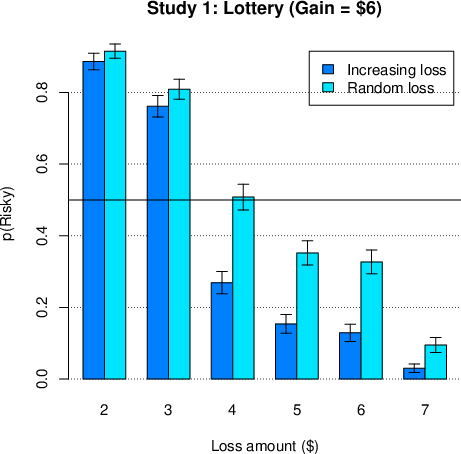
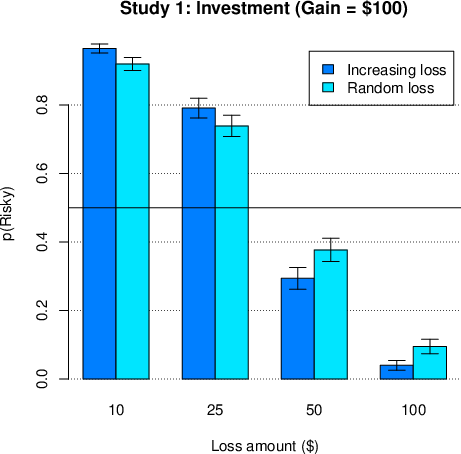
| λ | 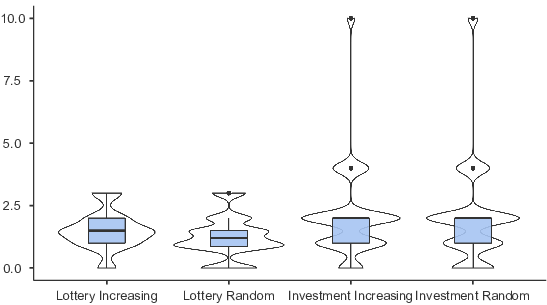
|
| Figure 1: Top: Study 1 results (replication of Mrkva et al., 2020). Top
panel: Proportion of individuals selecting the risky option in the lottery
and investment task as a function of the order condition (increasing
versus random losses) and size of losses (error terms denote standard
errors). Bottom: Violin plots displaying the distribution of λ
in Study 1. Wider areas of each violin indicate more participants with
that λ coefficient. Box plots display the median
(horizontal dark line) and interquartile range for each study. All study
conditions had median λ well over 1. |
2.2.1 Lottery task
Across conditions, for the symmetric gain-loss lottery task, only 22.8% of
the participants selected the risky option, which is significantly lower
than 50% (binomial test p < 0.001). This replicates Mrkva et
al.’s (2020) findings that have led to their conclusion that loss aversion
emerges even for small losses. Our modeling analysis similarly revealed
that for the lottery task, the average λ was 1.46 (with a median
of 1.50; see Figure 1 bottom panel).
Examining the effect of item order, we find that, on average, participants
took significantly more risk when items were randomized than when losses
were increasing (t(398) = 5.21, p < .001). The average
λ in the increasing losses condition was 1.59 compared to only
1.32 in the random loss condition (the respective medians were 1.50 and
1.20). Therefore, steadily increasing losses biased participants in the
direction of loss aversion.
2.2.2 Investment task
For the item with symmetric gains and losses (of $100), only 6.8% of the
participants selected the investment, which appears to be consistent with
loss aversion (binomial test p < .001). Modeling revealed a
corresponding average λ of 2.38 (median λ = 2.00). In
this task, the effect of random order was not significant (t(398) = 0.44,
p = .33).
2.2.3 Additional effects
There was no effect of gender on the estimated λ in the lottery
task (t(360) = 1.85, p = .07) but there was a significant effect in the
investment task (t(384) = 3.45, p < .001), with men having lower
estimated loss aversion in this task.7 With respect to age, however, there was no correlation
in either task (Lottery: r = -0.01, p = .80: Investment: r = -0.03, p =
.59), which does not replicate the results of Mrkva et al. (2020) that
older individuals tend to be more loss averse. We also did not replicate
the correlation between λ and ranked education in either task (r
= 0.07, p = .19; r = 0.03, p =.56, respectively).
3 Study 2: Symmetric random items and the effect of accept/reject
framing
In this study and in the remaining studies the lottery and investment tasks
were modified such that losses were symmetric in terms of their distance
above and below the gain outcomes. For instance, the lottery task (shown
in Table 1) produced a win of $6 and a loss of either $4, $5, $6, $7,
or $8. In this symmetric task, random noise does not bias towards loss
aversion. We used the version of Study 1 where the order of the items was
randomly determined for each participant. Finally, we manipulated the
possible strength of the status quo effect. Though the instructions for
the two tasks were the same (see below), in one condition participants
were given choices between accepting and rejecting the lottery. In this
accept/reject framing the status quo is that one does not possess the
lottery (i.e., reject). In the alternative choice-framing condition
participants were given a choice between getting the lottery and getting
zero, and thus the status quo was less clear. Accordingly, we examined
whether a task with balanced gains and losses and random order would
eliminate the loss aversion observed for small losses; and also evaluated
the potential influence of the status quo effect.
| Table 1: Outcomes in the lottery and investment task used in Study 2. Gains
and losses were presented with equal (50%) probabilities. The lottery
task was also used in Studies 5 and 6. |
| Item | Lottery (gain/loss) | Investment (gain/loss) |
| 1 | $6 / –$4 | $100 / –$25 |
| 2. | $6 / –$5 | $100 / –$50 |
| 3. | $6 / –$6 | $100 / –$100 |
| 4. | $6 / –$7 | $100 / –$150 |
| 5. | $6 / –$8 | $100 / –$175 |
3.1 Method
3.1.1 Participants
We recruited 401 Prolific Academic participants (193 females, 202 males, 6
other) to take part in this study. Their average age was 34.6 (SD = 12.9).
From this sample, 201 participants were randomly allocated to the
accept/reject framing condition and 200 were allocated to the choice
framing condition. Participants in both conditions received a fee of $1
for completing the study.
3.1.2 Task
The revised lotteries for both tasks appear in Table 1. Items were
presented randomly. Task instructions were as in Study 1, with the
complete instructions available in Appendix A. In the accept/reject
framing condition the lottery was shown in one line (e.g., “If the coin
turns up head, then you lose $6; if the coin turns up tails, then you win
$6”) while the response, shown in the line below, was either “Accept” or
“Reject”. In the choice framing condition the first line indicated “Choose
one of the options” and in the response line below participant selected
between the lottery (e.g., “50% chance to lose $6 and 50% chance to win
$6”) and an option of getting zero (i.e., “get 0”). As in Study 1, each
item was presented on a separate screen, and the two tasks included 10
items. After completing the two tasks participants filled in demographic
and financial questionnaires (see supplementary section). Modeling
analyses were conducted as in Study 1.
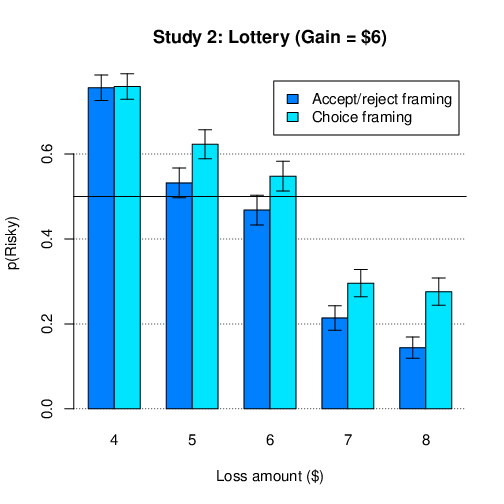
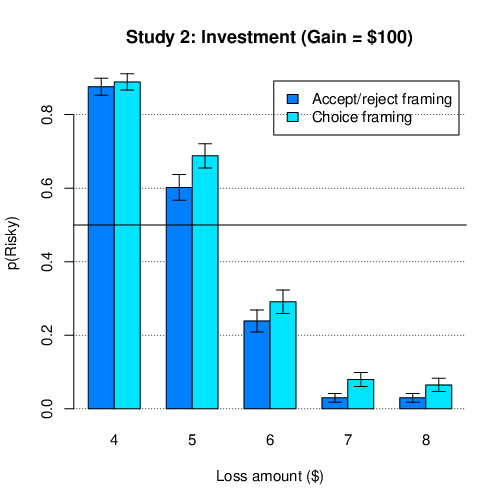
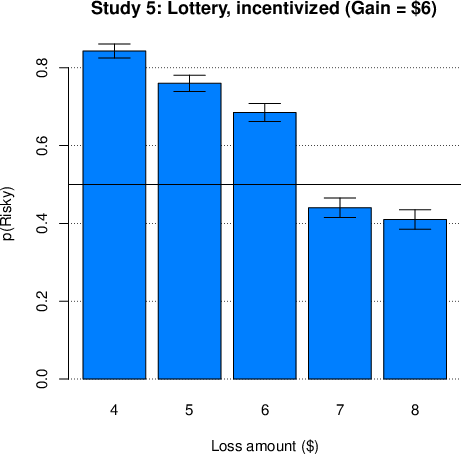
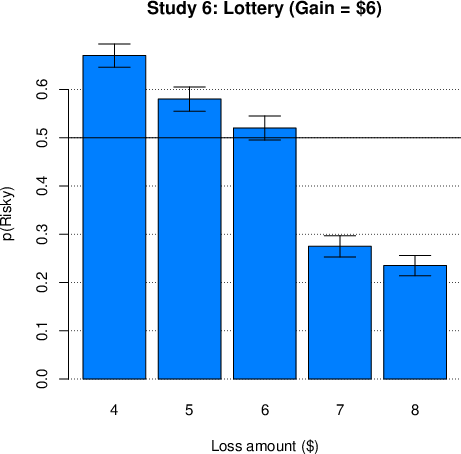
| Figure 2: Study 2, 5, and 6 results using symmetric items. Proportion
of individuals selecting the risky option in the lottery and investment
task as a function of the framing condition (accept/reject vs. choice
framing) and size of losses. Error terms denote standard errors. |
3.2 Results
The mean responses to the different items in the two tasks are shown in
Figure 2 top panel. As in the previous study, participants were highly
sensitive to the gains/losses ratio and on average modified their
risk-taking level monotonically with the size of the loss.
3.2.1 Lottery task
Across conditions, in this symmetric gain-loss task version, 50.7% of the
participants picked the risky option, which is not significantly different
from 50% (binomial test p = .80), and indicates gain-loss neutrality.
Consistently with this, our modeling analysis revealed that the average
λ was 0.92 (the median was 1.0; see Figure 3). The
effect of the accept/reject framing was in the direction of loss aversion
(t(398) = 2.33, p = .02). The average λ for the
accept\reject framing was 1.00, while for the choice
framing it was 0.84 (respective medians were 1.00 and 0.86).
| λ | 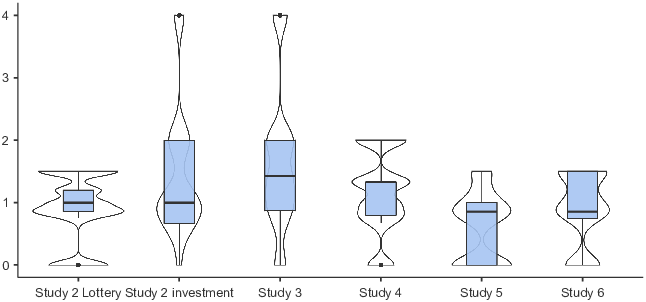
|
| Figure 3: Violin plots displaying the
distribution of λ in Studies 2-6. Wider areas of each violin
indicate more participants with that λ coefficient. Box
plots provide the median (horizontal dark line) and interquartile range
for each study. The median Lamda approached 1 in the lottery task in
Study 2, 5, and 6 in which symmetric small losses and gains were used.
Also, in Study 4 with a moderate loss of $40, only about half (51%) of
the participants had λ above 1. |
:
3.2.2 Investment task
For the item producing a loss and a gain of $100, 27% of the participants
selected the investment, which is somewhat higher than in Study 1, though
still consistent with loss aversion (binomial test p < .001).
Modeling revealed an average λ of 1.45 (median λ =
1.00; see Figure 3). The lower median is partially due to the low
granularity of the task; namely most participants rejected the symmetric
loss/gain investment but accepted the one with a somewhat lower loss.
Again, the effect of the accept/reject framing was in the direction of
loss aversion for all lotteries (t(398) = 2.19, p = .03) denoting the
biasing effect of this phrasing.
3.2.3 Additional effects
As in Study 1, we observe no effect of gender on λ estimated in
the lottery task (t(338) = 0.33, p = .74) while in the investment task we
do find an effect of gender (t(378) = 2.41, p < .02), with men
having lower loss aversion estimates.8 With respect to age, we
find no significant correlation for the lottery task (r = 0.03, p = .63)
but a weak correlation for the investment task (r = 0.11, p = .04), thus
partially replicating the correlation found in Mrkva et al. (2020). For
conciseness, similar analyses in all subsequent studies are included in the
supplementary section and summed up in the general discussion.
4 Study 3: High stake lotteries versus investments
In Study 2 we found loss aversion in the investment task and no loss
aversion in the lottery task when using symmetrical items. There are two
main differences between the two tasks: the first is the size of the
outcomes, and other is the framing of the task as lotteries versus
investment. Possibly, participants in an investment context want to feel
that they gain money rather than stay even (Shang, Duan & Lu, 2021), and
for this reason may be more loss averse in this task. We therefore
manipulated the task context to involve either a risky lottery or an
investment. The payoffs used in the current study were those of the
(revised) investment task used in Study 2. In addition, because in Study 2
it was difficult to characterize the median of the loss aversion
parameter, we added items so that there was a finer grain of losses (as
shown in Table 2).
| Table 2: Outcomes in the lottery and investment task used in Study 3 and 4.
Gains and losses were presented with equal (50%) probabilities. Outcomes
in Studies 3 and 4 were presented as either lotteries or investments (in
two conditions). |
| | Study 3 (large losses) | Study 4 (moderate losses) |
| Item | (gain/loss) | (gain/loss) |
| 1 | $100 / –$25 | $40 / –$20 |
| 2. | $100 / –$50 | $40 / –$30 |
| 3. | $100 / –$70 | $40 / –$40 |
| 4. | $100 / –$85 | $40 / –$50 |
| 5. | $100 / –$100 | $40 / –$60 |
| 6. | $100 / –$115 | $20 / –$20 |
| 7. | $100 / –$130 | $10 / –$10 |
| 8. | $100 / –$150 | |
| 9 | $100 / –$175 | |
4.1 Method
4.1.1 Participants
A total of 400 participants (219 females, 174 males, 7 other) volunteered
to take part in the study. Their average age was 35.8 (SD = 13.5). From
these participants, 201 individuals were randomly allocated to the
investment condition and the remaining 199 were allocated to the lottery
condition. Participants in both conditions received a fee of $1 for
completing the study.
4.1.2 Task and analysis
The study included a single task which was performed using either the
instructions of the lottery task or those of the investment task (see
Appendix A). Task outcomes are shown in Table 2. As in Study 2, the order
of the items was randomized for each participant. Items were administered
using the choice-framing format, namely with the first line in each item
indicating “Choose one of the options” and the response line below
involving a selection between the lottery or the investment and getting
zero (e.g., “50% chance you could win $100 and 50% chance you could
lose $25” or “get 0”). As previously, following the main task
participants completed a short demographic test (see supplementary
section). Analyses were conducted as in the previous studies.
4.2 Results
The mean responses to the different items are summarized in Figure 4. As
evident in the figure, participants again seemed to be sensitive to the
size of gains and losses. They also seemed to be relatively unaffected by
whether the task involved lotteries or investments. Across task
conditions, only 33.5% of the participants select the risky option with
symmetric gains and losses, which was significantly below 50% (binomial
test p < .001)), thus replicating our results in Study 2.
Modeling analyses revealed an average λ of 1.64 (median of 1.43;
see Figure 3). Participants came closest to equal rates of risky and safe
choices when the gain was $100 and the loss was $70 (in this case 44.8%
picked the risky option, slightly differing from 50%; binomial test p =
.04). When examining the effect of task type we find no significant
difference across items (t(398) = 0.62, p = .40). Thus, we find that it is
not the investment context that produces what appears like loss aversion
for high amounts, but rather the magnitude of losses. High magnitudes
provide sufficient conditions for the emergence of a loss-aversion like
behavior. An examination of gender and age differences appears in the
supplementary section.
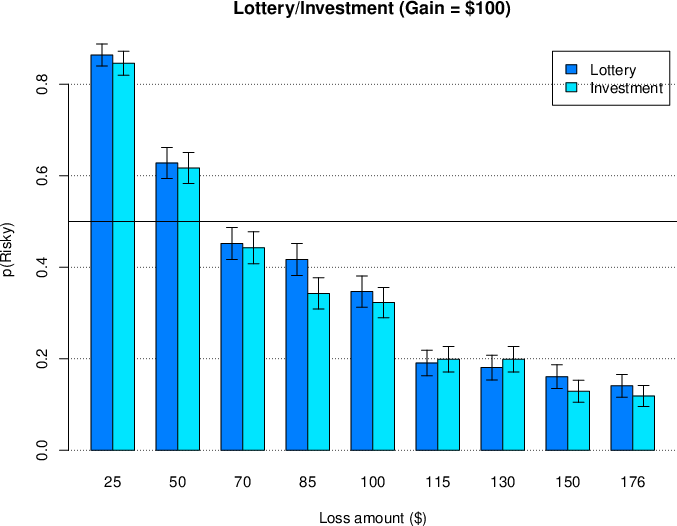
| Figure 4: Study 3 results. Proportion of individuals selecting the risky
option in the lottery/investment tasks as a function of the size of the
loss. Error terms denote standard errors. |
5 Study 4: Moderate losses
One could argue that the absence of loss aversion only emerges for the
small loss of $6 in the lottery task but not for less trivial losses. In
this study we examined lotteries with symmetric gains and losses of either
$10, $20, and $40, along with items with varying gains and losses, as
shown in Table 2. Specifically, outcomes in the investment task used in
Study 2 were reduced by a factor of 2.5 (resulting in a mean loss of
$40), and two items were added with symmetric gains and losses of $10
and $20. For robustness, we administered the task as either a lottery or
an investment task (as in Study 3).
5.1 Method
5.1.1 Participants
A total of 400 participants (218 females, 180 males, 2 other) took part in
the study. Their average age was 37.7 (SD = 14.1). From these individuals,
200 were randomly allocated to the investment task and 200 to the lottery
task. Participants in both conditions received a fee of $1 for completing
the study.
5.1.2 Task and analysis
As in the previous study, participants completed a single task which was
performed either with the instructions of the lottery task or the
investment task (see Appendix A). Task payoffs appear in Table 2. Items
were administered using the choice-framing format, and in random order.
This task was followed by a short demographic survey (see supplementary
section). The analysis was as in the previous studies, though we
separately examined the response to items with symmetric gain/loss
magnitudes ($10, $20, $40) in order to evaluate the effect of payoff
size. In the modeling analysis we only included items with varying gains
presented for the same loss ($40).
5.2 Results:
Mean responses to the different items are summarized in Figure 5. As can be
seen, participants’ tendency to avoid the risky lottery
depended on the magnitude of gains and losses. Again, our initial focus
was on the lotteries with symmetric gains and losses. When responding to
the $40 gain/loss item, only 34.5% of the participants selected the
risky option, significantly below 50% (binomial test p < .001).
However, for the item with a gain/loss of $20, 49.8% of the participants
preferred the risky option (binomial test p = .96), while for the $10
loss/gain 63.8% preferred to take risk (binomial test p < .001,
above 50%). Thus, behavioral indications of loss aversion started to
emerge only for losses of $40.
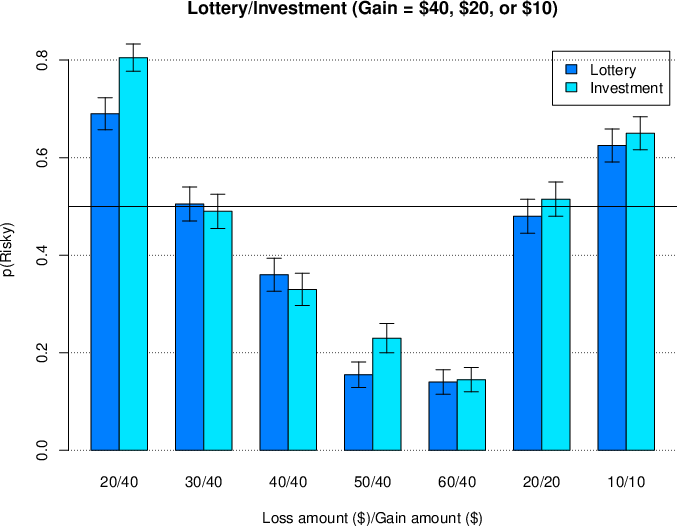
| Figure 5: Study 4 results. Proportion of individuals selecting the risky
option in the lottery/investment tasks as a function of the size of gains
and losses. Error terms denote standard errors. |
Focusing on the items with a fixed $40 gain and a mean $40 loss, our
modeling analysis reveals an average λ of 1.16 (median of 1.33;
see Figure 2), which is rather low in comparison to previous estimates
(e.g., Mrkva et al., 2020). Indeed, for the average $40 loss only 51.0%
of the participants had λ above 1. For the $20 loss the best
proxy of the mean λ appears to be 1.0 (given the proximity of
choices to preference neutrality), while for the amount of $10,
λ seems to fall well below this value (though we cannot estimate
it using the current task). Finally, there was no effect of task type on
choices across items (t(398) = 0.96, p = .34), showing that the current
results are robust to task instructions.
6 Study 5: Effect of incentivization
In Studies 2 and 4 we find that for lotteries and investments with small
gains and losses, up to $20, individuals do not display loss aversion.
However, one might argue that this is due to the fact that gains and
losses in our previous studies were not incentivized. Though Mrkva et al.
(2020) also did not incentivize participants in the lottery and investment
tasks, one might argue that hypothetical losses produce different response
from actual losses (e.g., Holt & Laury, 2002). We therefore aimed to
evaluate whether for small incentivized lotteries as well, individuals do
not exhibit loss aversion. For this purpose, we used an incentivized
version of the lottery task in Study 2 (see Table 1).
6.1 Method
6.1.1 Participants
A total of 400 participants (230 females, 166 males, 4 other) took part in
the study. Their average age was 36.5 (SD = 13.8). Participants received a
fee ranging between $1 to $15 for completing the study, based on their
choices and the realization of the lotteries. Specifically, there was a
$1 participation fee while the remaining amount was based on
participants’ choices and the realization of a randomly selected lottery.
6.1.2 Task and analysis
In this study all participants performed the lottery task. Items were
administered using the choice-framing format, and in random order. The
only difference between the current study and the choice-framing condition
of Study 2, is that choices were incentivized. Specifically, participants
were initially informed that in addition to their participation fee of
$1, an amount of $8 would be deposited at their temporary account, and
that at the end of the task the temporary account will be added to their
participation fee. Also, as part of the lottery/ investment task
instructions, participants were informed that one of the
lotteries/investments will be randomly selected and based on their choice
it will be either played or not, and that any resulting gains or losses
will affect their temporary account (see complete instructions in Appendix
A).
6.2 Results
The mean responses to the different items are summarized in Figure 2 bottom
left panel. For symmetric gains and losses of $6, we find that 68.5% of
the participants preferred the lottery over the safe option, significantly
above 50% (binomial test p < .001). Our modeling analysis
indicated an average λ of 0.64 (median of 0.86; see Figure 3)
which denotes gain seeking (opposite of loss aversion). Most participants
(68.8%) had λ estimates below 1. Furthermore, the lottery where
responses were closest to 50% involved a gain of $6 and a loss of $7.
Only 56% of the participants avoided this lottery (binomial test p =
.02). Our results thus show that incentivization did not produce loss
aversion.
7 Study 6: Relationship with the endowment effect
In our final study we leave our main focus on the weighing of gains and
losses, and examine the relationship between risk taking for gains and
losses and valuation of objects. Mrkva et al. (2020) argued that, if both
risk aversion and the endowment effect are driven by loss aversion, the two
behavioral phenomena should correlate positively. This was strongly
supported in their study with a positive correlation of 0.55 between the
extra surplus an individual charged as a seller compared to a buyer, and
the loss aversion parameter estimated for risky lotteries. However, an
alternative account is that the correlation is due to the same “subject
misconceptions” (to borrow a term used by Plott & Zeiler, 2005) by the
same individuals in both tasks. Particularly, since both tasks in Mrkva et
al. (2020) adopted the same paradigm of steadily and monotonically
increasing costs, the correlation could be due to the resulting tendency of
some individuals to treat items inter-relatedly (see footnote 4). We
therefore supplemented the lottery task with a buying and a selling
task. As in Mrkva et al. (2020) participants performed one task at the
beginning of the experiment and at the other at the end, with
counter-balanced order. However, while the buying and selling tasks used
monotonically increasing prices as in Mrkva et al. (2020), our risk-taking
task involved randomly presented gains and losses as in Study 2-5. Another
difference was that Mrkva et al. (2020) used a physical object (car model)
as the endowed object, while we used a lottery ticket. A recent
meta-analysis evidenced strong endowment effects for lottery tickets
similar to those observed for other commodities (Yechiam, Ashby & Pachur,
2017).
7.1 Method
7.1.1 Participants
A total of 400 participants (196 females, 198 males, 6 other) took part in
the study. Participants were randomly allocated into two order conditions.
Two- hundred performed the selling task first and the buying task last,
and 200 performed the tasks in reverse order. Participants’ average age
was 35.5 (SD = 13.2). They received a fee ranging from $1 to $1.6 based
on their choices and the realization of the lotteries in the
buying/selling tasks. Specifically, there was a $1 participation fee and
the remaining amount was based on their choices.
7.1.2 Task
The initial task was either a buying or a selling task. In the selling task
participants were informed that they are given a lottery ticket with a
1/100 chance to win 20 experimental dollars which they could keep or sell
to the organizers of the study. In the buying condition participants had
the opportunity to buy the same lottery ticket. The instructions for both
conditions were adopted from Mrkva et al. (2020) and appear in Appendix B.
Importantly, as in Mrkva et al. (2020) participants were incentivized for
their buying/selling decisions, with a conversion rate of $1 for each 100
experimental dollars. The initial buying/selling task was followed by the
lottery task which was administered with choice framing and random order of
items, and was not incentivized, as in Mrkva et al. (2020). Next,
participants completed a demographic questionnaire, and a longer financial
survey (from Mrkva et al., 2020; see our
supplemen) that was
used as a filler, followed by the remaining selling/buying task.
7.1.3 Analysis
We calculated selling and buying prices for all participants based on the
lowest price which sellers agreed to sell, and the highest price that
buyers agreed to buy. We also conducted an analysis in which we removed
buyers and sellers who exhibited inconsistent responses (e.g., selling in
a certain price but then refusing to sell given a higher price). We first
tested whether there was an endowment effect by using a repeated-measures
ANOVA with condition (buying/selling) and task order as within-subject
factors. Next, we calculated each individual’s selling premium by
deducting each individual’s buying price from their selling price. We then
replicated our examination of loss aversion in the lottery task as in the
previous studies. Finally, we examined the correlation between the selling
premium and choices in the lottery task as well as the estimated
λ parameter.
7.2 Results
Participants’ mean selling price (i.e., willingness to accept price; WTA)
was $4.28 (SE = 0.16), compared to a mean buying price (i.e., willingness
to pay; WTP) of $2.47 (SE = 0.11), denoting a 1.73 relative increase in
selling estimates. An ANOVA examining the endowment effect and the order
of the buying/selling task showed that the selling premium was
significantly above zero, F(1,398) = 109.50, p < .001). The
effect of the task order was also significant (F(1,398) = 12.16, p
< .001), with higher valuations for those initially allocated to
the selling conditions: On average $5.66 (SE = 0.15) compared to 4.51 (SE
= 0.15) for those who bought first.
The results of the lottery task are shown in Figure 2 bottom right panel.
As can be seen, we replicate our finding of no behavioral loss aversion
for the item with symmetric gains and losses. For this item, 52.0% of the
participants picked the risky lottery (binomial test p = .45). An
estimation of λ conducted as in the previous studies revealed a
mean λ of 0.91 (median of 0.86; see Figure 3).
We next examined the correlation between the selling premium and risk
taking in the lottery task as the individual level. We first focused on
the mean tendency to avoid losses across lotteries. We recover a
correlation of 0.17 (p < .001) between the endowment effect and
avoidance of the lotteries. We thus replicate the positive correlation
observed in Mrkva et al. (2020) though in our study it is considerably
smaller. Indeed, behavioral responses to the gain-loss lotteries account
for only 2.9% of the variance in the selling premium. We find a similar
correlation between the selling premium and λ (r = 0.16, p =
.001).
We also conducted a robustness test that focused on individuals who
performed the selling and buying task without any inconsistencies. This
removed 14% of the selling estimates and 21.5% of the buying estimates
(the greater coherence of selling price is consistent with that found in
other studies; see Yechiam et al., 2017). The results for this subset
showed a significant endowment effect, with a mean selling price of $4.75
compared to a buying price of $2.95 (F(1,276) = 79.36, p <
.001) and again a small positive correlation between risk avoidance in the
lottery task and the selling premium, r = 0.20, p < .001.
8 An analysis of first presentation effects
One might argue that the design of the current studies involving multiple
items could bias responses towards loss neutrality despite the balanced
range of expected values and random order, because some items are typically
presented before the target lotteries with equal-sized gains and
losses. Thus, it was important to examine these key lotteries when
presented first. To evaluate this, we examined the responses to the
lotteries involving same sized gains and losses when these were
administered as the first lotteries (to about 1/k of the participants,
where k is the number of items which ranged from 5 to 9 in different
studies), or not. The results are presented in Figure 6, and relevant
statistical analyses appear in the
supplemen. As can be
seen, in all studies across key lotteries, the results trended in the
direction of lower loss aversion when these items were presented
first. A statistical analysis, available in the supplementary section,
shows that this effect was significant in some of the studies, and that it
consistently emerged when the loss amount was small ($6). Interestingly,
in Study 1 which uses Mrkva et al.’s original task conditions, when the
item with symmetric gains and losses of $6 is presented first, eliminating
the effect of asymmetrical outcome sizes and any type of order effect,
participants also did not significantly avoid the lottery (53% chose to
enter the lottery; see supplementary section). Importantly, these results
do not imply that those who were not presented with the target
prospects first, showed loss aversion for smaller amounts (except in Study
1 which replicated Mrkva et al.’s task conditions). The rate of those who
were presented with these key prospects first was relatively small and
therefore removing these participants from the sample does not markedly
change the results reported in our main analysis, as shown in Figure 6 and
analyzed in the supplementary section.
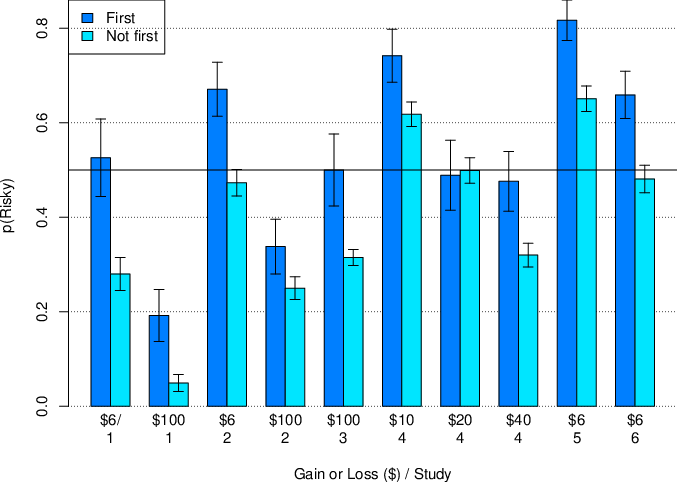
| Figure 6: First-presentation effects in the studies in which the order of
the lotteries was randomized (Study 1 random-order condition, and Studies
2-6). Proportion of individuals selecting the risky option in the
lottery/investment tasks in items with identical-sized gains and losses,
as a function of whether it was the first presented lottery or not, and
given different sizes of (identical) gains and losses. Error terms denote
standard errors. |
9 Discussion
Our first study showed that Mrkva et al.’s (2020) findings of apparent loss
aversion for small losses are replicable in online participants. However,
our next set of five studies show that they are driven by design features
in the list method used by Mrkva et al. (2020) and others (e.g., Tversky
& Kahneman, 1992), especially the non-symmetric gains and losses and
non-random order. In Studies 2–6 we find that when gains and loss items
are symmetrical, namely when the average loss is equal to the average
gain, and items are administered randomly, individuals do not behave in a
strong loss-averse manner unless the losses are high (around $100).
Specifically, for average losses of up to $20 participants did not show
loss aversion, even in a condition when they were incentivized. For an
average loss of $40 participants showed weak loss aversion with a mean
λ of 1.16 and with only 51% of the participants having
λ estimates above 1. In tasks with higher losses averaging
$100, we do observe what appears to be loss aversion. Yet even in these
higher stakes lotteries/investments, our estimate of λ for
symmetric items is not as high as in previous studies (e.g., Tversky &
Kahneman, 1992; Mrkva et al., 2020), with a mean λ of 1.54
across studies. This indicates that differently from the notion espoused
in prospect theory, the λ coefficient is not constant across
different loss amount, but instead is highly dependent on the amount, and
goes to 1 or below for smaller amounts.
Our findings also show that a variety of task-related factors can bias
participants to behave in an apparent loss averse manner. As noted at the
outset these factors include: a) items with asymmetric sizes of gains and
losses, b) monotonically increasing/decreasing loss amounts which may
lead to perceived inter-item relationships, and c) the usage of an
accept/reject framing for possible options. In Study 1 we found a notable
effect of randomizing items. Even given non-symmetrical gains and losses,
randomizing items reduced loss aversion by about half (from λ of
1.59 to 1.32, on average). In Study 2 we found that changing the
asymmetric loss/gain items to symmetrical ones and randomizing item order
provided sufficient conditions for the complete disappearance of loss
aversion with small losses. In this study we also found that not using an
accept/reject framing further reduces loss aversion. By contrast, a factor
that was not found to affect choices (in Studies 3–4) is the framing of
the task as a lottery or an investment (Shang et al., 2021).
Our analysis of order effects in all studies indicated that loss aversion
in symmetric gain/loss lotteries was apparently further reduced when
small-sized lotteries were presented first. This is consistent with Ert
and Erev’s (2013) finding that loss aversion was lower when tasks are
relatively simple, though they did not find a significant order effect in
their study. This first-presentation effect is an interesting and hitherto
unobserved moderator of people’s sensitivity to losses.
In addition, our final study examined the relationship between the
sensitivity to gains and losses in lotteries and the endowment effect. To
our surprise, we did find a small positive correlation between these
indices, consistently with Mrkva et al. (2020). The correlation admittedly
could be weak because the two measures are noisy and not necessarily
because they are unrelated. This suggests that the weighting of gains and
losses may be implicated to some degree in both phenomena at the individual
level. However, it is quite erroneous to extrapolate from these findings
that loss aversion “drives” both phenomena at the population
level. Simultaneously with the positive correlation at the individual
level, we found no loss aversion for the average participant in the lottery
task compared to a huge endowment effect for the same
participants. Moreover, the endowment effect was observed for a lottery
with a moderate amount (nominal outcome of $20) for which no loss aversion
emerged in our studies. Thus, it does not seem to make sense to refer to
the same construct as underlying both phenomena.
We also do not replicate the correlation with age and education observed by
Mrkva et al. (2020) consistently across studies. In particular, as
detailed in the supplementary section, the positive correlation between
loss aversion and age appeared only sporadically, in one of our studies.
The only consistent individual difference factor affecting choices was
gender, but its effect was not coherent across payoff magnitudes, being
present only for risks involving large losses. This again emphasizes the
fact that the loss aversion parameter is not stable given different payoff
magnitudes.
Notice that some of these effects can be captured by expected utility
theory (von Neumann & Morgenstern, 1944). Most especially the absence of
loss aversion for small amounts and increased risk aversion with stake
size can be captured if one assumes a certain wealth level to which
outcomes are added, and a diminishing marginal utility of wealth (Hansson,
1988). Indeed, the current findings seem to reconcile (or at least
alleviate) the paradoxical EU theory predictions implied by assuming loss
aversion for lower losses (Hansson, 1988; Rabin, 2000). However, other
aspects of our findings, such as the reduced loss aversion with random
order, and the first presentation effect, violate the procedural
invariance assumption of expect utility theory. Also, another implication
of risk aversion contingent on wealth level which does not emerge in our
data, is that (in approximation) loss aversion should be sensitive to
one’s income (similarly, Mrkva et al., 2020 also found inconsistent
correlations between income and loss aversion in their studies).
Limitations of our study include the reliance on online participants from
Prolific Academic, namely individuals who have experience in engaging in
behavioral experiments. One could ask whether for these individuals, our
presentation of potential losses or even actual losses in Study 5 was
sufficient to produce the same kind of feeling one gets when losing money
out of one’s own wallet. A further limitation is our usage of a fixed text
of “get $0” for the outcomes of the safe alternative, which may have been
unattractive to the participants. While we cannot directly address these
issues with the current dataset (and indeed the former is difficult to
examine without some ethical issues), we can say that we do replicate in
this population and paradigm the very high degrees of loss aversion found
in Mrkva et al. (2020) when we use the exact same conditions of their
study: non-symmetric gains and losses, an order effect, and a status quo
effect.9 Still, we realize further studies
should validate the possibility that experience in participation in
decision making studies, particularly online, might alleviate the loss
aversion tendency.
To sum, when using non-symmetric items we do replicate Mrkva et al.’s
(2020) results of “loss aversion” even for small amounts and in an online
sample, but using balanced symmetric gains and losses and random items
this is not replicated. Instead, we find that loss aversion does not
emerge for small amounts and emerges very weakly for a moderate amount
($40). This finding has important ramifications to the question for
whether loss aversion exists. As aptly noted by Mrkva et al. (2020), a
critical implication of loss aversion is that for small amounts as well
individuals overweigh losses compared to gains. Moreover, loss aversion
implies that the ratio of inflating losses over gains should be constant
over different amounts. The findings that loss aversion does not emerge
for small losses and is much weaker for moderate losses suggest that there
is no grand simple explanation related to the subjective weighting of
gains and losses across different amounts. We hope that new models are
developed to account for these findings.
10 References
Abdellaoui, M., Bleichrodt, H., & L’Haridon, O. (2008). A
tractable method to measure utility and loss aversion under prospect
theory. Journal of Risk and Uncertainty, 36, 245–266.
Argaman, E., Ludvig, E. A, & Yechiam, E. (2020). Probability errors of
buyers and sellers, loss aversion, and loss attention. Unpublish
manuscript. Technion- Israel Institute of Technology.
Brown, A. L., Imai, T., Vieider, F., & Camerer, C. F. (2021).
Meta-analysis of empirical estimates of loss-aversion (2021). CESifo
Working Paper No. 8848, Available at SSRN:
https://ssrn.com/abstract=3772089.
Budescu, D. V., Wallsten, T. S., & Au, W. T. (1997). On the importance of
random error in the study of probability judgment. Part II: Applying the
stochastic judgment model to detect systematic trends. Journal of
Behavioral Decision Making, 10, 173–188.
Ert, E., & Erev, I. (2013). On the descriptive value of loss aversion in
decisions under risk: Five clarifications. Judgment and Decision
Making, 8, 214–235.
Gal, D. (2006). A psychological law of inertia and the illusion of loss
aversion. Judgment and Decision Making, 1, 23–32.
Gal, D., & Rucker, D. (2018). The loss of loss aversion: Will it loom
larger than its gain? Journal of Consumer Psychology,
28, 497–516.
Hansson, B. (1988). Risk aversion as a problem of conjoint measurement. In
P. Gardenfors & N.-E. Sahlin (Eds.), Decision, probability, and
utility (pp. 136–158). NY: Cambridge University Press.
Hermann, D. (2017). Determinants of financial loss aversion: The influence
of prenatal androgen exposure (2D:4D). Personality and Individual
Differences, 117, 273–279.
Holt, C. A., & Laury, S. K. (2002). Risk aversion and incentive effects.
American Economic Review, 92, 1644–1655.
Kahneman, D. (2011). Thinking, fast and slow. Detroit, MI: Macmillan.
Kahneman, D. & Tversky, A. (1979). Prospect theory: An analysis of
decision under risk. Econometrica, 47, 263–291.
Markowitz, H. M. (1952). Portfolio selection. Journal of Finance,
7, 77–91.
Morewedge, C. K., & Giblin, C. E. (2015). Explanations of the endowment
effect: An integrative review. Trends in Cognitive Sciences,
19, 339–348.
Mrkva, K., Johnson, E. J., Gächter, S., & Herrmann, A. (2020). Moderating
loss aversion: Loss aversion has moderators, but reports of its death are
greatly exaggerated. Journal of Consumer Psychology, 30,
407-428.
O’Donoghue, T., Somerville, J. (2018). Modeling risk aversion in economics.
Journal of Economic Perspectives, 32, 91–114.
Plott, C. R., & Zeiler, K. (2005). The willingness to pay-willingness to
accept gap, the “endowment effect,” subject
misconceptions, and experimental procedures for eliciting valuations.
American Economic Review, 95, 530–545.
Pratt, J. W. (1964). Risk aversion in the small and in the large.
Econometrica, 32, 122-136.
Rabin, M. (2000). Diminishing marginal utility of wealth cannot explain
risk aversion. In D. Kahneman & A. Tversky (Eds.), Choices,
values and frames (pp. 202-208). NY: Cambridge University press.
Rakow, T., Cheung, N. Y., & Restelli, C. (2020). Losing my loss aversion:
The effects of current and past environment on the relative sensitivity to
losses and gains. Psychonomic Bulletin & Review, 27,
1333–1340.
Schild, C., Lilleholt, L., & Zettler, E. (2019). Behavior in cheating
paradigms is linked to overall approval rates of crowdworkers.
Journal of Behavioral Decision Making, 34, 157–166.
Segal, U., & Spivak, A. (1990). First order versus second order risk
aversion. Journal of Economic Theory, 51, 111–125,
Shang, X., Duan, H., & Lu, J. (2021). Gambling versus investment: Lay
theory and loss aversion. Journal of Economic Psychology,
84, 102367.
Sharpe, W. F. (1964). Capital asset prices: A theory of market equilibrium
under conditions of risk. Journal of Finance, 19,
425-442.
Thaler, R. (1980). Toward a positive theory of consumer choice.
Journal of Economic Behavior and Organization, 1, 39–60.
Tversky, A., & Kahneman, D. (1992). Advances in prospect theory:
Cumulative representation of uncertainty. Journal of Risk and
Uncertainty, 5, 297–323.
von Neumann, J., & Morgenstern, O. (1944). Theory of games and economic
behavior. Princeton University Press, Princeton, NJ.
Walasek, L., Mullett, T. L., & Stewart, N. (2018). A meta-analysis of loss
aversion in risky contexts. Working paper. Available at
http://dx.doi.org/10.2139/ ssrn.3189088.
Walasek, L., & Stewart, N. (2019). Context-dependent sensitivity to
losses: Range and skew manipulations. Journal of Experimental
Psychology: Learning, Memory, and Cognition, 45, 957–968.
Yechiam, E. (2019). Acceptable losses: The debatable origins of loss
aversion. Psychological Research, 83, 1327–1339.
Yechiam, E., Ashby, N. J. S., & Pachur, T. (2017). Who’s biased? A
meta-analysis of buyer-seller differences in the pricing of risky
prospects. Psychological Bulletin, 143, 543–563
Yechiam E., & Hochman, G. (2013). Losses as modulators of attention:
Review and analysis of the unique effects of losses over gains.
Psychological Bulletin, 139, 497–518.
Appendix A: Lottery and investment task instructions
General instructions
In this study, you will answer a brief survey including some demographic
questions as well as some questions about hypothetical preferences. The
duration of the study will be about 5-7 minutes. In return for completing
the survey, you will be awarded $1.
Study 5/6: In addition, an amount of $8/$0.2 is deposited at your
temporary account. This amount may increase or decrease depending on your
choices during the study. At the end of the task, your temporary account
will be added to your $1 participation fee, and your final fee will be
$1 to $15/$1.6.
Lottery task
Suppose you were offered an opportunity to enter a lottery based on a toss
of a fair coin. If the coin turns up heads, you lose some money; if it
turns tails, you win some money. Please indicate for each lottery whether
you would ’accept’ that is play the
lottery, for a chance of winning or
’reject’ it and not receive anything.
Investment task
Suppose you were offered an opportunity to make an investment where you had
a 50% chance of winning $10010 and a 50% chance of losing various set
amounts. Would you make any of the following investments?
Study 5 (only): One of the lotteries/investments will be randomly selected
and based on your choice it will be either not played (and you will get 0
for it) or played with a virtual coin having 50% chance of turning either
heads or tails. The resulting gains or losses will be added to/ deducted
from your temporary account.
Appendix B: Incentivized buying and selling instructions
Buying task
We will offer you the chance to buy the following lottery ticket with a
1/100 chance to win 20 Experimental Dollars. This lottery ticket can be
yours! If you want to acquire this lottery ticket, you can buy it from the
organizers. Please indicate below for each respective price if you are
ready to buy the lottery ticket.
• If at the price for which we sell the lottery ticket to you, you have
indicated that you are ready to buy, you will receive the lottery ticket
from us at this price, which you have to pay to us. Then we will inform
you whether the lottery ticket won.
• If at the price for which we sell the lottery ticket to you, you have
indicated that you are not ready to buy, you do not receive the lottery
ticket.
The price at which we will sell the lottery ticket to you will be randomly
determined by us and for sure be between 0 and 10 Experimental dollars.
That is, our selling price will be determined by rolling dice after you
have filled in the table. All prices are equally likely.
Since you cannot influence the selling price, which we will determine
randomly, you have an incentive to state the price that corresponds to
your true preference.
Once you have made your choice, you cannot change it anymore. We are also
not able to negotiate the randomly determined selling price.
For each 100 experimental dollars, you gain/ lose $1 (actual dollars) and
this will be added/ deducted from your fixed amount of $1.2 (actual
dollar) earning for the experiment.
If the price is $X11
o I am ready to buy
o I am not ready to buy
Selling task
We will give you the following lottery ticket with a 1/100 chance to win 20
Experimental dollars which you can keep. This lottery ticket is yours! If
you do not want to keep the lottery ticket, you can sell it to the
organizers of this study. Please indicate below for each respective price
if you are ready to sell the lottery ticket.
• If at the price for which we buy the lottery ticket from you, you have
indicated that you are ready to sell, you will receive this amount of
experimental dollars instead of the lottery ticket.
• If at the price for which we buy the lottery ticket from you, you have
indicated that you are not ready to sell, you will keep your lottery
ticket and one lottery outcome will be randomly selected at the end of the
study.
The price at which we will buy your lottery ticket will be randomly
determined by us and for sure be between 0 and 10 Experimental dollars.
That is, our buying price will be determined by rolling dice after you
have filled in the information below. All prices are equally likely.
Since you cannot influence the buying price, which we will determine
randomly, you have an incentive to state the price that corresponds to
your true preference. Once you have made your choice, you cannot change it
anymore. We will also not be able to negotiate the randomly determined
buying price.
For each 100 experimental dollars, you gain/ lose $1 (actual dollars) and
this will be added/ deducted from your fixed amount of $1.2 (actual
dollar) earning for the experiment.
If the price is $X12
o I am ready to sell
o I am not ready to sell
This document was translated from LATEX by
HEVEA.











